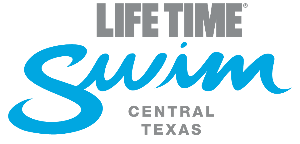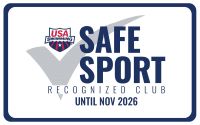Developmental / SWIM FIT/ Nickel
Swimmers need a basic understanding of freestyle and backstroke and the components of breaststroke and butterfly. These athletes will focus on fine tuning butterfly and breaststroke, drills, equipment, and turns. They will learn what swim team is all about and begin to learn the discipline to become a bronze level swimmer. Swimmers must be able to swim 50 yards of freestyle and backstroke. Coaches will be in and out of the water with this group.
- Focus is on basic techniques as swimmers work on the fundamentals of each stroke through kicking, stroke drills, and limited swimming.
- This group may or may not participate in the USA Swimming meets instead an intra-squad meet or fun meet with other developmental groups is recommended.
- Practice equipment includes kick-boards, noodle pieces (a cut up noodle to assist in keeping arms out front for freestyle and to place between the chin and chest to emphasize good head position).
- Typically practice will be held in the Indoor Leisure pool.
- Practice will be approximately 45 minutes
Bronze Group
Swimmers have a basic understanding of swimming skills. Refinement and continued development of these skills are the main objective of this group. The points of emphasis are swimming satisfaction, fun, stroke technique and beginning competition. Swimmers must be able to swim a minimum of 50 meters of freestyle and backstroke and 25 meters of breaststroke and butterfly. The Breaststroke and Butterfly are close to legal USA level stroke.
- The focus is almost entirely on teaching fundamentals and developing basic motor learning skills, balance and coordination in the water.
- It is important to make swimming fun and enjoyable. The most significant responsibility for coaches of Bronze swimmers is teaching young people to love the water and to love the sport.
- Emphasis of the correct fundamentals and willingness to sacrifice speed for efficiency. This concept can sometimes work against a swimmer’s short-term success at this age. At this level, there is great merit in competition based on skill development
- Promotion and development of each of the four strokes. Age groupers are not recommended to specialize in practice or in meets.
- Heavy emphasis on kicking. Coaches make kicking a high percentage of the conditioning work done at the Bronze levels.
- At every level, but particularly the Bronze level, we take a long-term approach to swimmer development. Once swimmers begin in our program, we want them to have the preparation and tools they will need to make swimming a lifetime activity.
- Practice equipment includes but is not limited to kick-boards, fins, and noodle pieces.
- Practice will be approximately 60 minutes
Silver Groups
Swimmers are able to swim all four strokes legally and maintain good technique on low intensity interval work. This phase is a transitional level where the emphasis begins to change from primarily teaching to a relatively equal balance of technique work and physiological development. Swimmers also have a moderate level of competitive swimming experience. Dry land training, endurance, conditioning, stroke refinement, race strategy, competitive skills, goal setting and an understanding of time standards are emphasized.
- Still centered on teaching fundamentals and developing a strong foundation in all strokes.
- Swimmers are encouraged to attend 3 to 4 practices offered each week.
- Low intensity aerobic conditioning is emphasized and athletes begin to do more yardage on a weekly basis. It is important that the fundamental skills developed in earlier levels not be compromised as swimmers begin to swim farther in practice.
- Focus on preparation for the 200 IM and 200/500 freestyle events. Even if swimmers show promise in specific events, there is very little specialty work.
- Continued priority on kicking for all four strokes.
- Although the overall level of training expected of swimmers increases during this phase of the program, coaches are charged with being creative and making the experience fun and enjoyable.
- Practice equipment includes kick-boards, pull buoys, fins, and noodle pieces.
- Practice will be approximately 60-75 minutes
Gold Group
Swimmers have a high level of competitive swimming experience. This group is designed to transition swimmers from age group swimming to senior swimming through an increased volume and intensity of training. The focus is to improve cardiovascular fitness, refine stroke skills and gain competitive experience.
- Swimmers are encouraged to attend five practices per week, depending on the age of the swimmer. Regular practices attendance is crucial for both swimming improvement and injury prevention.
- Gold swimmers should display a high level of commitment, work ethic, personal responsibility and sportsmanship.
- Yardage completed each week begins to be an important consideration.
- Build a solid foundation for continued improvement by emphasizing distance freestyle and IM training. Continue to work on all strokes and distances in both practice and meets.
- Although aerobic conditioning is still the highest priority, athletes begin to do more anaerobic threshold work.
- Practice equipment includes kick-boards, fins, pull buoy, and paddles.
- Practice will be approximately 75-90 minutes
Senior Group
Swimmers at the Senior level are the most developed athletes on the team. These swimmers are preparing for future regional and national level meets. These swimmers are expected to dedicate a greater deal of time in the pool and to dryland work. Swimmers are also expected to swim double workouts.
- Swimmers are expected to attend all workouts through the week including morning workouts and dryland sessions.
- Seniors must be year round swimmers dedicated to improvement and hard work.
- Practice equipment includes kick-boards, fins, pull buoys, paddles, a snorkel - see coach for their equipment list
- Dry-land workout becomes more rigorous and includes weight training.
- Practice times will be approximately 120-180 minutes(with dryl-and)



